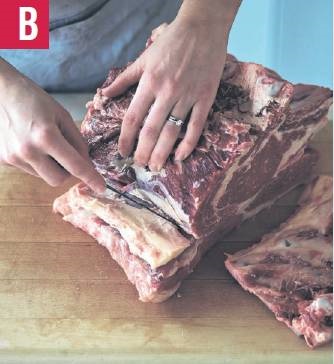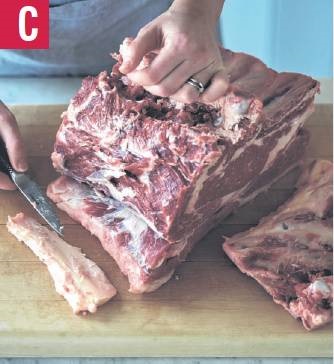
This might just be my beef favouritism showing itself again, but this my favourite type of ‘‘cooktchery’’ to do and it looks very impressive.
The bones are large and not as fiddly as lamb or pork, so you can really get stuck into it with knives to take off as much or as little as you’d like.

1. The ‘‘chine’’ is the flat side of bone running from the corner where the ends of the ribs meet. We want to take this off whatever we do, as it’s great for flavour but a pain when trying to carve. So get a knife underneath it and slice along to detach the bone from the meat. Wiggle a boning knife along the corner (A) to remove the piece completely - it’s quite tough at the join of the ribs, so just be determined, it will come away. Remember not to worry if you leave a bit of meat on the bone, it doesn’t matter.
2. Keep the chine to the side as we’re going to use it for a roasting joint.
3. Then turn the rib on its end and, depending on which side of the animal it’s from, you’ll find a blade bone in the side of the piece. This is the end of the scapula. This might have already been taken out, but you’ll see it and be able to feel it if it’s there. Just slide a knife around the top and the bottom and twist it out.

4. Next we need to remove the nuchal ligament or ‘‘paddywhack’’ (B). This is in all quadrupeds and basically, it helps hold the head up. It’s almost pure protein, so would be very nutritious, but it’s also like a big thick rubber band, and no amount of slow-cooking or tenderising would make it good in terms of taste or to digest. However, dogs love it and it’s the best natural dog chew. Just dry it for a couple of days to harden even more - leave it out on the side or in your fridge. It’s not good for dogs if they swallow it, so keep it really dry so they’re not tempted to swallow it whole .

To get to the nuchal ligament, look again at the joint side on. Pointing towards where you started to cut the chine will be a thick yellowy piece, about 3cm wide (C). It runs all the way through, so you can’t cut it out like the scapula; just pull back the top, or ‘‘jacket’’, of the rib (use a knife to help) so that you can cut or pull out the paddywhack.
5. Now, if we’re roasting, we might want to cut or saw through to make a smaller piece, or we might roast the whole piece. The smaller piece is called the ‘‘fore rib’’ because it’s at the fore end of the animal, not to be confused with a ‘‘four rib’’ if it has four ribs on it. That’s technically a fore four rib!
6. It’s up to you if you want to trim the top of the bones. You don’t have to, you can just cook it like this and it will be lovely. For a bit more presentation, cut down around the tops of the bones to expose about 2.5 cm at the top. Scrape well so they’re nice and clean after roasting. The meat you cut off is delicious and fatty and it’s lovely in casseroles, so either keep it in the fridge for up to a week or pop it in the freezer for another time.

7. For roasting, though this isn’t vital, you can now tie the ‘‘chine’ back on to the bottom (D). Like all cooking with the bone, the chine works as a natural heat conductor and helps the heat run through the main part (eye) of the joint. It also helps to keep the moisture in by sealing this side of the beef. And it will help produce more and richer liquids in the bottom of the roasting tray for making gravy. You just put it back along the bottom and use the butcher’s twine to tie it back on. Once the meat is roasted, just snip the strings and discard the chine so that the joint is easier to carve. Put the joint rib-side down and just carve from the top of the muscle.
8. If we’re going to break the joint down some more or just use half of it for a roasting joint, we can remove the whole or half ‘‘jacket’’ (E). There is a natural seam that you’ll see with the fat through the meat where you can cut the top off. Essentially, it’s the rib-eye joint still on the bone. This is ‘‘cote de boeuf’’ and it’s sometimes sold as trimmed joints, the width of two or more ribs, or it’s sliced between the ribs for very large steaks (for two to share), which, as you can imagine, have all the juice and flavour of a rib-eye steak plus the moisture and the cooking benefits of having the rib still attached. It’s a terrific cut and looks impressive for entertaining, too.
9. To use the jacket, either dice or hand-mince for really flavoursome cuts or make a mini roast by folding it into a round bend and using the twine to cut it. It’s such a terrific cut of meat that it’s great to use it for something like this, and it’s so juicy that dryroasting even a small piece like this can’t fail.
10. For the remaining part, we can now also remove the rib bones and slice just the centre meat into rib-eye steaks
(F). The cut in the middle is, helpfully, already very even, so you just need to get equal widths for a perfect set of steaks, which will be ready to fry, griddle or cook on the barbecue/outdoor grill as you wish.












